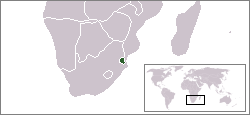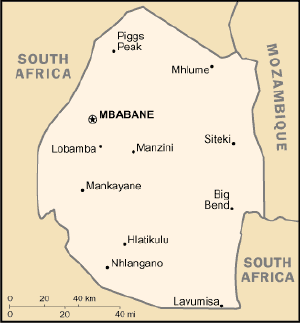Difference between revisions of "Swaziland" - New World Encyclopedia
Mary Anglin (talk | contribs) (claim article) |
({{Contracted}}) |
||
| Line 1: | Line 1: | ||
| − | {{Claimed}}{{Images OK}} | + | {{Claimed}}{{Images OK}}{{Contracted}} |
Revision as of 21:33, 3 February 2007
The Kingdom of Swaziland is a small country in southern Africa (one of the smallest on the continent), situated on the eastern slope of the Drakensberg mountains, embedded between South Africa in the west and Mozambique in the east. The country is named after the Swazi, a Bantu tribe.
| |||||
| National motto: Siyinqaba (We Are the Fortress) | |||||

| |||||
| Principal languages | Swati, English | ||||
| Capitals | Mbabane (administrative) Lobamba (royal and legislative) | ||||
| King | Mswati III | ||||
| Prime minister | Themba Dlamini | ||||
| Area - Total - % water |
Ranked 153rd 17,363 km² 0.9% | ||||
| Population - Total (2001) - Density |
Ranked 150th 1,173,900 65/km² | ||||
| Independence | 1968 | ||||
| Currency | Lilangeni | ||||
| Time zone | Universal Time + 2 | ||||
| National anthem | Nkulunkulu Mnikati wetibusiso temaSwati (O Lord, Our God, Bestower of Blessings upon the Swazi) | ||||
| Internet TLD | .sz | ||||
| Country calling code | 268 | ||||
History
Human remains and artifacts from more than 100,000 years ago have been found in Swaziland. Evidence of agriculture and iron use dates from about the fourth century, and people speaking languages ancestral to current Sotho and Nguni languages began settling no later than the eleventh century. The ruling Dlamini lineage had chiefships in the region in the eighteenth century. An enlarged Swazi kingdom was established by Sobhuza I in the early nineteenth century. Soon thereafter the first whites started to settle in the area. In the 1890s the South African Republic in the Transvaal claimed sovereignty over Swaziland but never fully established power. After the South African War of 1899-1902, Swaziland became a British protectorate. The country was granted independence on September 6, 1968. Since then, Swaziland has seen a struggle between pro-democracy activists and the totalitarian monarchy.
Politics
The head of state is the king, which since 1986 has been King Mswati III. By tradition, the king reigns along with his mother (the Indovuzaki, lit. Great She-Elephant), the former viewed as the administrative head of state and the latter as a spiritual and national head of state. As the monarch, the king not only appoints the prime minister — the head of government — but also appoints a small number of representatives for both chambers of the Libandla (parliament). The Senate consists of thirty members, while the House of Assembly has sixty-five seats, fifty-five of which are occupied by elected representatives (elections are held every five years in November).
The 1968 constitution was suspended in 1973 in a State of Emergency decree still in force today. In 2001 King Mswati III appointed a committee to draft a new constitution. Drafts were released for comment in May 2003 and November 2004. However, they were strongly criticized by civil society organizations in Swaziland and human rights organizations elsewhere.
King Mswati III is often criticized for living so lavishly in a nation that is afflicted by one of the world's highest HIV infection rates. His fleet of luxury cars and millions spent on refurbishing his numerous wives' luxury mansions are at odds with the approximately 34 percent of the nation that stand unemployed, nearly 70 percent of whom live on less than a dollar a day, and with around 39 percent of adults afflicted by HIV.
Economy
In this small, landlocked economy, subsistence agriculture occupies more than 80 percent of the population. The manufacturing sector has diversified since the mid-1980s. Sugar and wood pulp remain important foreign exchange earners. Mining has declined in importance in recent years, with only coal and quarry stone mines remaining active. Surrounded by South Africa, except for a short border with Mozambique, Swaziland is heavily dependent on South Africa, from which it receives nine-tenths of its imports and to which it sends more than two-thirds of its exports. Customs duties from the Southern African Customs Union and worker remittances from South Africa substantially supplement domestically earned income. The government is trying to improve the atmosphere for foreign investment. Overgrazing, soil depletion, drought, and sometimes floods persist as problems for the future. More than one-fourth of the population needed emergency food aid in 2002 because of drought, and more than one-third of the adult population was infected by HIV. In 2004 Swaziland acknowledged for the first time that it has one of the highest AIDS rates in the world, with almost 40 percent of adults infected with HIV. Prime Minister Themba Dlamini has declared a humanitarian crisis due to the combined effect of drought and land degradation, increasing poverty and HIV/AIDS. The United Nations special envoy on AIDS, Stephen Lewis, said “Swaziland stands alone with the world's highest rate of HIV infection after nearby Botswana made headway against the deadly pandemic.”
Geography
Swaziland offers a wide variety of landscapes, from the mountains along the Mozambican border to savannas in the east and rainforest in the northwest. Several rivers flow through the country, such as the Lusutfu River. With fifty thousand inhabitants, the capital city of Mbabane is the largest town in the nation; others include Manzini, Lobamba, and Siteki.
Demographics
The majority of the population consists of Swazi, but there are also small numbers of Zulu, Europeans, and Mozambican refugees. The official languages are Swati and English; the latter is also the official written language. The chief religion is Christianity, often in a form blended with several indigenous religions. There are also Jewish and Muslim communities.
Culture
Government
- Swaziland Government official government site
- Ministry of Tourism official site
News
- allAfrica - Swaziland news headline links
- Times of Swaziland newspaper
Credits
New World Encyclopedia writers and editors rewrote and completed the Wikipedia article in accordance with New World Encyclopedia standards. This article abides by terms of the Creative Commons CC-by-sa 3.0 License (CC-by-sa), which may be used and disseminated with proper attribution. Credit is due under the terms of this license that can reference both the New World Encyclopedia contributors and the selfless volunteer contributors of the Wikimedia Foundation. To cite this article click here for a list of acceptable citing formats.The history of earlier contributions by wikipedians is accessible to researchers here:
The history of this article since it was imported to New World Encyclopedia:
Note: Some restrictions may apply to use of individual images which are separately licensed.
